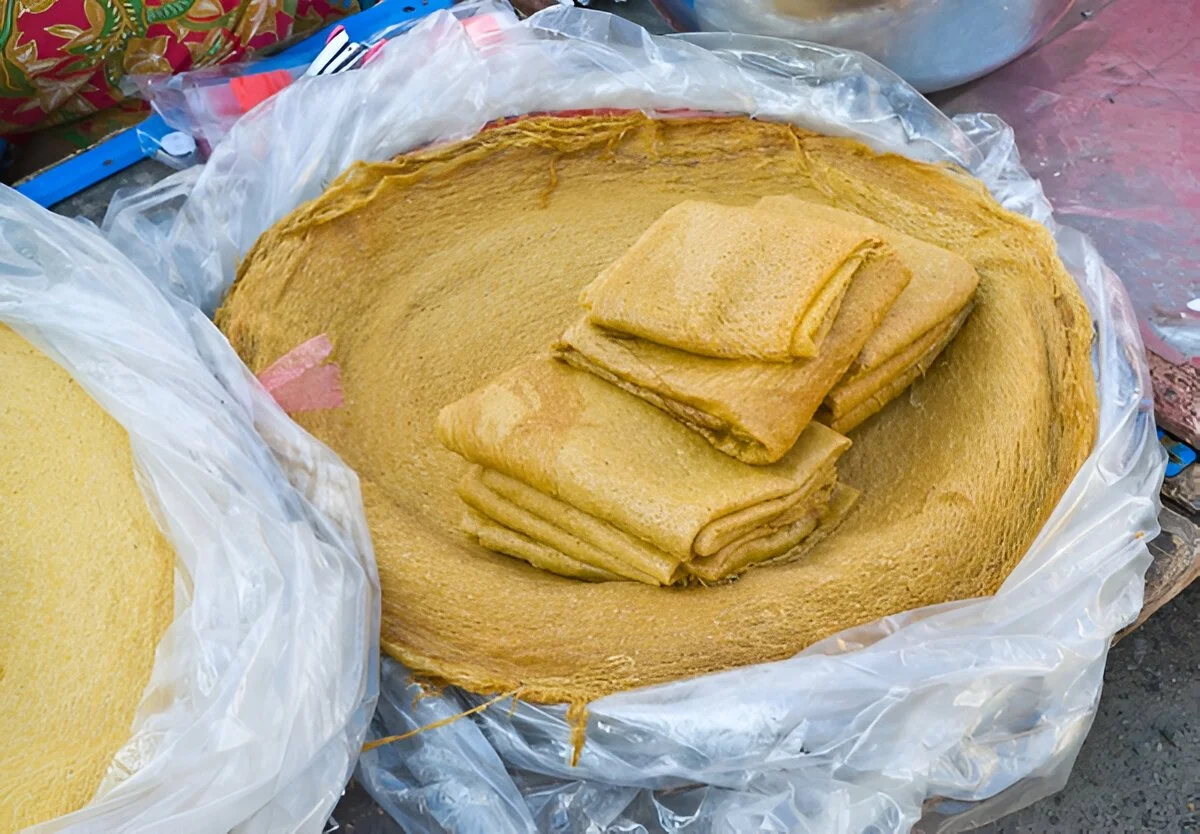Halloween Special: The Ghostly Sightings of “Giant Ghosts” in front of Wat Suthat
If you stroll past the Giant Swing, you'll encounter a magnificent golden temple, contrasting beautifully with the white of its entrance and surrounding walls. This place is called Wat Suthat Thepwararam, a temple that boasts the longest Ubosot (ordination hall) in all of Thailand.
Inside the ordination hall, you'll find a large golden Buddha statue. And if you look closely at the walls, you'll discover stunning mural paintings depicting various stories. Now, if you gaze towards the left of the Buddha image and walk to the 4th pillar of the temple all the way to the back, then look up towards the top of the pillar near the lamp, you'll see an unusual painting. It's an illustration of a creature with a humanoid appearance but an abnormally tall and slender body. It's lying down with monks standing around it.
A mural painting in Wat Suthat depicting a Pred laying down on the ground, appearing to be suffering and hungry.
In Thailand, we call this creature 'Pret เปรต'. Prets are Thai ghosts that have been the subject of countless folklore tales for centuries. What exactly are they? Why do they have such unusual, elongated bodies? And do they truly exist? Today, we're going to uncover the answers.
The word 'Pret' is derived from Sanskrit. Its meaning translates to 'gone' or 'one who has gone before’. Simply put, it refers to a deceased person. Thai people believe that ghosts known as 'Pret' are the result of a person committing sins during their lifetime, such as harming their parents. As a consequence, after death, they are said to have tall, elongated bodies that obstruct them from entering houses, and their hands, which were used to harm their parents, become as large as palm leaves, making it difficult for them to grasp anything. Their mouths are as small as needle holes, obstructing them from eating as they desire. This tormented existence, devoid of any comfort, is a fate that no one would wish upon themselves.
A depiction of many different types of Pret (Image credit: สมุดภาพไตรภูมิ ฉบับกรุงศรีอยุธยา – ฉบับกรุงธนบุรี เล่ม 2)
Consequently, when Thais hear the word 'Pret,' they associate it with negative connotations. It is seen as an evil spirit or a sinful being. In some cases, it is used as an insult, and some people consider it to be a vulgar term. For instance, Pret can be used to call little naughty children as “Dek Pret” meaning Pret children to imply that the children display really bad attitudes and behaviors. Additionally, parents also use the concept of Pret to teach their child to behave by enforcing certain beliefs such as do not hit your parents or your hands will become as big as palm leaves just like the Pret or in another case, if you curse at your parents, when you pass away, your mouth will become as small as needles just like Pret.
In southern Thailand, we have a tradition related to the 'Pret' ghosts called 'Sath Deun 10' which mostly takes place every October. Thai people believe that during the 10th month, 'Pret' ghosts are released from the world of the dead and come to the human world. Therefore, rituals are held to make merit and offer blessings to them. Various types of sweets are prepared, suitable for the characteristics of the 'Pret'. For example, 'Khanom La', a type of thin noodle, is made because the 'Pret' has a mouth as small as a needle hole, and thus can eat it. It is believed that 'Khanom La' is the food of the 'Pret' ghosts. Alternatively, some believe that 'Khanom La' represents clothing for the 'Pret' ghosts, as it resembles a piece of cloth.
A picture of “Khanom La” (Image credit: https://cooking.kapook.com/view96524.html)
So why is there a painting of a 'Pret' lying down in Wat Suthat? This painting was created during the reign of King Rama III. The presence of a 'Pret' painting serves as a reminder to those who see it to be mindful of their actions and the consequences of their deeds. It is meant to teach people about the law of karma, according to Buddhist principles.
However, there are also local stories passed down from the past that claim the area around Wat Suthat used to be quite scary. Some people living near the temple have reported encounters with a male and female 'Pret' ghost haunting the area. People have described seeing tall, shadowy figures wandering around. However, some people have offered alternative explanations, suggesting that these might have been shadows of the Giant Swing cast in the morning mist, leading people to mistakenly believe they were seeing ghosts.
the giant swing in front of Wat Suthat, leading people to confuse the infrastructure as Pred during foggy mornings!
Ultimately, these are just stories and beliefs, and it's up to each individual to decide whether it’s true or not. It's clear that the belief in 'Pret' ghosts has been deeply ingrained in Thai culture for centuries. It has influenced many aspects of Thai life, from religious rituals to serving as a reminder for people to do good deeds and avoid evil. If you're interested in seeing the painting of the 'Pret' ghost, you can visit the ordination hall of Wat Suthat. There's a 100 Baht entrance fee. The temple is open daily from 8:00 AM to 8:00 PM. If you want to know more stories like these, check out our self guided audio tour here or subscribe to our newsletter!
Additional Readings: สมุดภาพไตรภูมิ ฉบับกรุงศรีอยุธยา – ฉบับกรุงธนบุรี เล่ม 2





